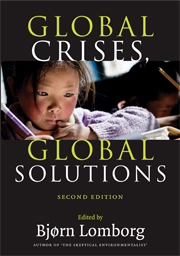Book contents
- Frontmatter
- Contents
- List of figures
- List of tables
- List of contributors
- Acknowledgements
- List of abbreviations and acronyms
- Introduction
- PART I THE CHALLENGES
- 1 Air pollution
- 2 The security challenge in conflict-prone countries
- 3 Disease control
- 4 The benefits and costs of alternative strategies to improve educational outcomes
- 5 Climate change
- 6 Hunger and malnutrition
- 7 Water and sanitation
- 8 The challenge of reducing international trade and migration barriers
- 9 Transnational terrorism
- 10 Women and development
- PART II RANKING THE OPPORTUNITIES
- Conclusion
9 - Transnational terrorism
Published online by Cambridge University Press: 05 June 2012
- Frontmatter
- Contents
- List of figures
- List of tables
- List of contributors
- Acknowledgements
- List of abbreviations and acronyms
- Introduction
- PART I THE CHALLENGES
- 1 Air pollution
- 2 The security challenge in conflict-prone countries
- 3 Disease control
- 4 The benefits and costs of alternative strategies to improve educational outcomes
- 5 Climate change
- 6 Hunger and malnutrition
- 7 Water and sanitation
- 8 The challenge of reducing international trade and migration barriers
- 9 Transnational terrorism
- 10 Women and development
- PART II RANKING THE OPPORTUNITIES
- Conclusion
Summary
Introduction
Major terrorist campaigns date back to the Jewish Zealots' struggle against the Roman Empire from 48 AD to 70 AD, the Hindu Thugs' brutal attacks against innocent travelers in India from 600 AD to 1836 AD, and the Assassins' actions against the Christian crusaders in the Middle East from 1090 AD to 1956 AD (Bloom, 2005; Rapoport, 1984). In fact, the Thugs may have murdered more than 800 people a year during their twelve-century existence (Hoffman, 2006, 82–83), making them twice as deadly on an annual basis as the modern era of terrorism (1968–2006). Some form of terrorism has characterized civilization for the last 2,000 years. Each of the two recent globalization periods has been associated with transnational terrorism that has international implications. In the earlier era of globalization starting in 1878 and ending in 1914, the anarchists waged a terrorist campaign that culminated in World War I. More recently, leftists and fundamentalists utilized transnational trrorism to capture headlines during the current era of globalization from the last third of the twentieth century to the present day.
During the modern era of transnational terrorism, terrorists crossed borders and, in some instances, staged incidents in foreign capitals to focus world attention on their cause or grievance.
- Type
- Chapter
- Information
- Global Crises, Global SolutionsCosts and Benefits, pp. 516 - 584Publisher: Cambridge University PressPrint publication year: 2009
- 26
- Cited by

